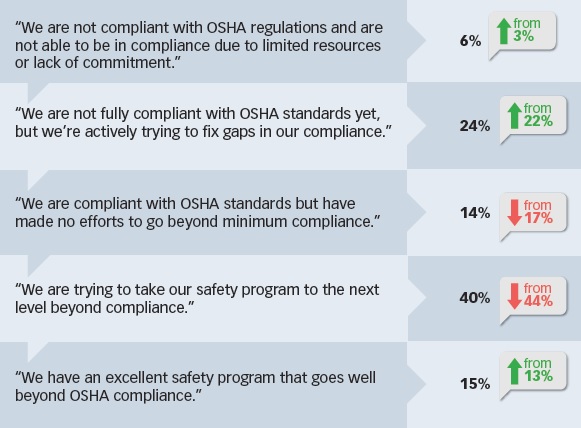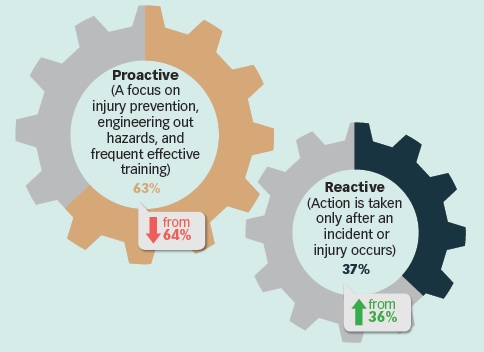The second Annual Safety Progress Report from SafeStart® and the EHS Daily Advisor shed some light on the real-world status of safety culture at organizations nationwide. While the survey results indicate some positive progress, they also show that a lot of work remains to be done.

The 2nd Annual Safety Progress Survey, conducted in late 2017, gathered the opinions and insights of 531 environmental, health, and safety (EHS) professionals who shared information regarding the overall state of safety at their companies. The goals for the annual survey and the Safety Progress Report based on its results include:
- Provide the safety industry with valuable insight into current challenges;
- Help facilitate safety improvements with relevant resources throughout the year; and
- Record progress annually.
With the survey and report, SafeStart and the EHS Daily Advisor aim to provide timely research to ensure we are all moving the safety needle in a positive direction to protect workers in all industries. Among the topics the yearly project examines is safety culture.

Going Beyond Compliance
Let’s start off with some good news. In our second year of polling, the share of participants who said “We have an excellent safety program that goes well beyond OSHA compliance” increased, from 13% to 15%. It is encouraging that organizations are continually seeking to take their safety programs beyond compliance and instill a companywide culture of safety.
Furthermore, over one-half (54%) of respondents said that their company’s current state of compliance is a step forward from the previous year. 41% indicated that their organization’s state of compliance was essentially the same year over year, which could mean different things for different companies, but at least these companies can say that their safety program is not getting weaker.
Not all of the news was good, however. Most notably, the share of survey respondents doubled—from 3% to 6%—who said “We are not compliant with OSHA regulations and are not able to be in compliance due to limited resources or lack of commitment.” The share of respondents who admitted their company had taken a step backwards in compliance over the past year also doubled. While this share is relatively small (4% this year and 2% last year), it’s a clear indication that when it comes to safety culture, there is plenty of room for improvement!
Proactive vs. Reactive; Safety vs. Production
 Year over year, the shares of participants who described their safety initiatives as mostly proactive or reactive held relatively steady. Just under two-thirds indicated their initiatives are proactive (focusing on injury prevention, engineering out hazards, and frequent training), while a bit over one-third have a more reactive culture (where action is taken only after an incident or injury occurs).
Year over year, the shares of participants who described their safety initiatives as mostly proactive or reactive held relatively steady. Just under two-thirds indicated their initiatives are proactive (focusing on injury prevention, engineering out hazards, and frequent training), while a bit over one-third have a more reactive culture (where action is taken only after an incident or injury occurs).
Safety and production can be at odds within company culture as well. For about one-quarter of participants (26%), safety always comes first. However, the same percentage said that production mostly wins out over safety. While only 6% of respondents said that production is always prioritized over safety, this share was unfortunately larger than it was in last year’s survey, when 5% said that productivity trumped safety in their company culture.
Not Many Safety Culture ‘Utopias’
In our survey, we presented 5 unique stages of safety culture, from “Realization” to “Utopia,” and here is how our respondents rated their organizations
- Realization (Recognizing action must be taken to correct issues): 9%
- Traditional (You have established policies and procedures, manage by objectives, and are in basic legal compliance with rules and regulations): 36%
- Observation (The supervisory level, driven by compliance, is more observant of behavioral safety but there is little employee involvement): 24%
- Empowerment (Employees are empowered to work as a team, peer-to-peer, to improve safety behaviors and performance): 29%
- Utopia (A strong and self-sustaining culture of safety throughout the organization that is employee-driven): 2%
While there aren’t many safety utopias out there today, it is encouraging to see that many of our respondents are climbing to higher levels of the safety culture ladder.
As the graphic below demonstrates, however, not all companies are taking great leaps forward—3% of respondents said that their organization’s safety culture had actually taken a step backward from the previous year.
For full survey results and analysis, you can download the Annual Safety Progress Report 2018 here.
How Can You Improve Your Safety Culture?
The findings in the Annual Safety Progress Report 2018 reveal that on the safety culture front, many organizations need help in order to drive positive change. Is your organization in the same position? Do you know you need to bring your safety culture to the next level, but aren’t sure how to do so?
If this sounds familiar, consider attending BLR’s Safety Culture 2018, taking place September 12–14 in Atlanta, Georgia. The event is a one-of-a-kind opportunity to network with fellow safety professionals and attend educational sessions led by safety culture thought leaders, experienced practitioners, and sought-after consultants.
Attendees of Safety Culture 2018 will learn strategies for:
- Supercharging your safety committees for maximum safety engagement and retention
- Engaging all employees in safety and instilling safety as a core company value
- Improving your safety training to ensure it is dynamic, motivating, and effective
- Measuring safety performance and culture with leading indicators and key metrics
- Identifying and eliminating cultural and behavioral hazards
- And much, much more!
Join us in Atlanta in September and start improving your safety culture as soon as possible—register now!


